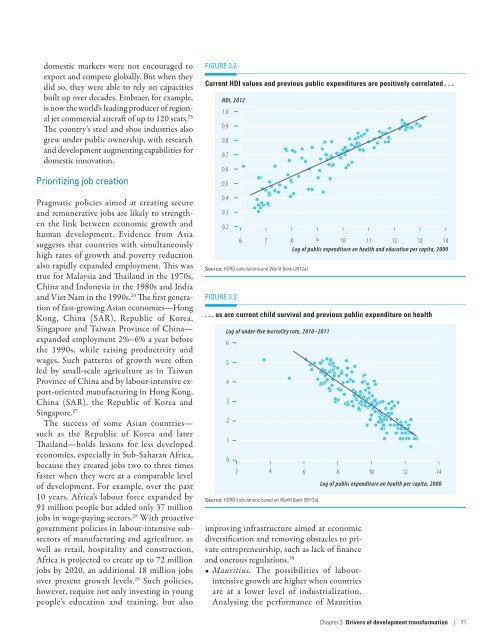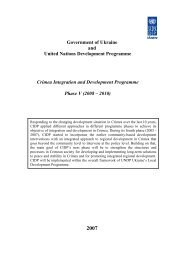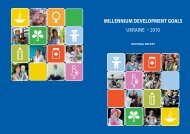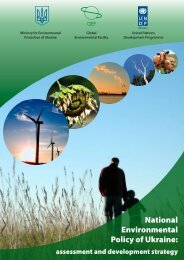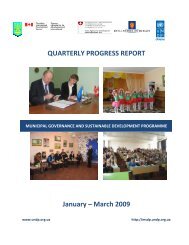E N S W - United Nations Development Programme
E N S W - United Nations Development Programme
E N S W - United Nations Development Programme
You also want an ePaper? Increase the reach of your titles
YUMPU automatically turns print PDFs into web optimized ePapers that Google loves.
domestic markets were not encouraged to<br />
export and compete globally. But when they<br />
did so, they were able to rely on capacities<br />
built up over decades. Embraer, for example,<br />
is now the world’s leading producer of regional<br />
jet commercial aircraft of up to 120 seats. 25<br />
The country’s steel and shoe industries also<br />
grew under public ownership, with research<br />
and development augmenting capabilities for<br />
domestic innovation.<br />
Prioritizing job creation<br />
Pragmatic policies aimed at creating secure<br />
and remunerative jobs are likely to strengthen<br />
the link between economic growth and<br />
human development. Evidence from Asia<br />
suggests that countries with simultaneously<br />
high rates of growth and poverty reduction<br />
also rapidly expanded employment. This was<br />
true for Malaysia and Thailand in the 1970s,<br />
China and Indonesia in the 1980s and India<br />
and Viet Nam in the 1990s. 26 The first generation<br />
of fast-growing Asian economies—Hong<br />
Kong, China (SAR), Republic of Korea,<br />
Singapore and Taiwan Province of China—<br />
expanded employment 2%–6% a year before<br />
the 1990s, while raising productivity and<br />
wages. Such patterns of growth were often<br />
led by small-scale agriculture as in Taiwan<br />
Province of China and by labour-intensive export-oriented<br />
manufacturing in Hong Kong,<br />
China (SAR), the Republic of Korea and<br />
Singapore. 27<br />
The success of some Asian countries—<br />
such as the Republic of Korea and later<br />
Thailand—holds lessons for less developed<br />
economies, especially in Sub-Saharan Africa,<br />
because they created jobs two to three times<br />
faster when they were at a comparable level<br />
of development. For example, over the past<br />
10 years, Africa’s labour force expanded by<br />
91 million people but added only 37 million<br />
jobs in wage-paying sectors. 28 With proactive<br />
government policies in labour- intensive subsectors<br />
of manufacturing and agriculture, as<br />
well as retail, hospitality and construction,<br />
Africa is projected to create up to 72 million<br />
jobs by 2020, an additional 18 million jobs<br />
over present growth levels. 29 Such policies,<br />
however, require not only investing in young<br />
people’s education and training, but also<br />
Figure 3.2<br />
Current HDI values and previous public expenditures are positively correlated . . .<br />
HDI, 2012<br />
1.0<br />
0.9<br />
0.8<br />
0.7<br />
0.6<br />
0.5<br />
0.4<br />
0.3<br />
0.2<br />
6 7 8 9 10 11 12 13 14<br />
Log of public expenditure on health and education per capita, 2000<br />
Source: HDRO calculations and World Bank (2012a).<br />
Figure 3.3<br />
. . . as are current child survival and previous public expenditure on health<br />
Log of under-five mortality rate, 2010–2011<br />
6<br />
5<br />
4<br />
3<br />
2<br />
1<br />
0<br />
2 4 6 8 10 12 14<br />
Source: HDRO calculations based on World Bank (2012a).<br />
improving infrastructure aimed at economic<br />
diversification and removing obstacles to private<br />
entrepreneurship, such as lack of finance<br />
and onerous regulations. 30<br />
• Mauritius. The possibilities of labourintensive<br />
growth are higher when countries<br />
are at a lower level of industrialization.<br />
Analysing the performance of Mauritius<br />
Log of public expenditure on health per capita, 2000<br />
Chapter 3 Drivers of development transformation | 71


